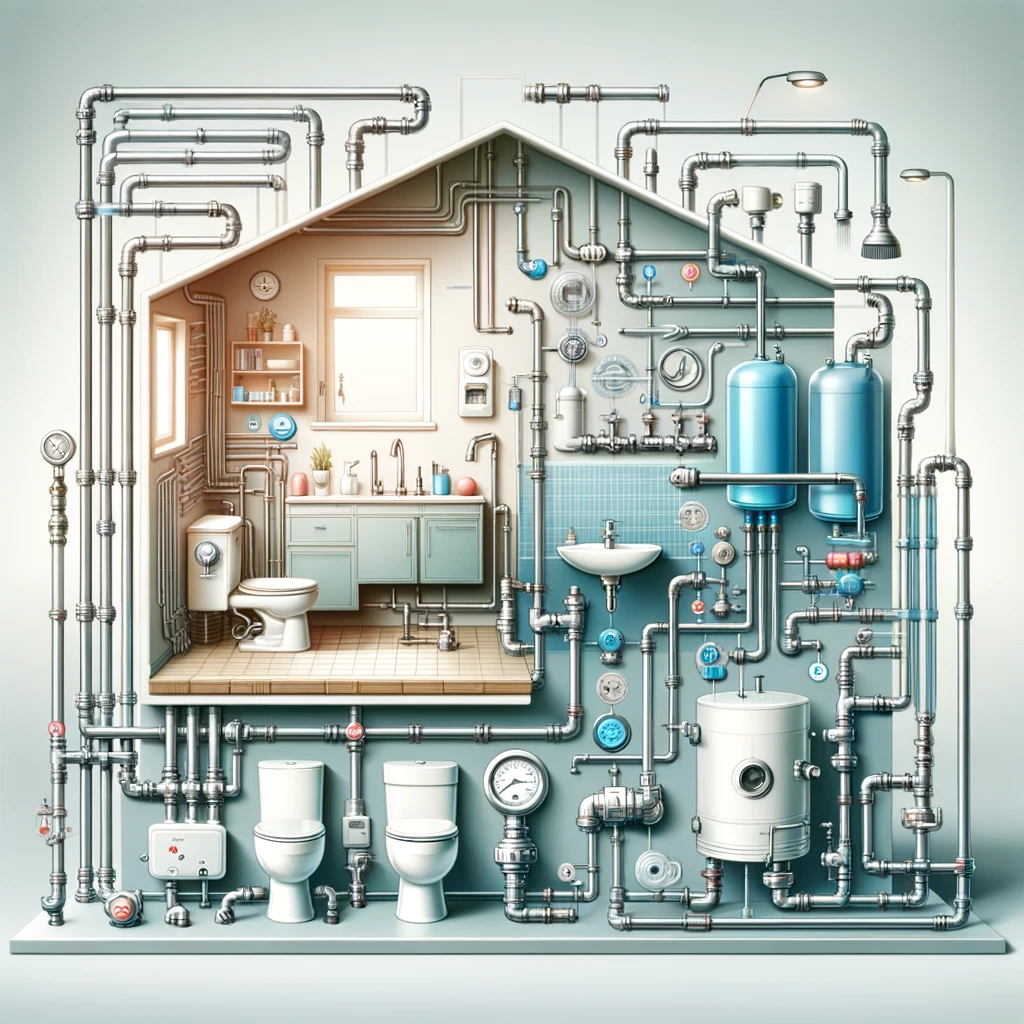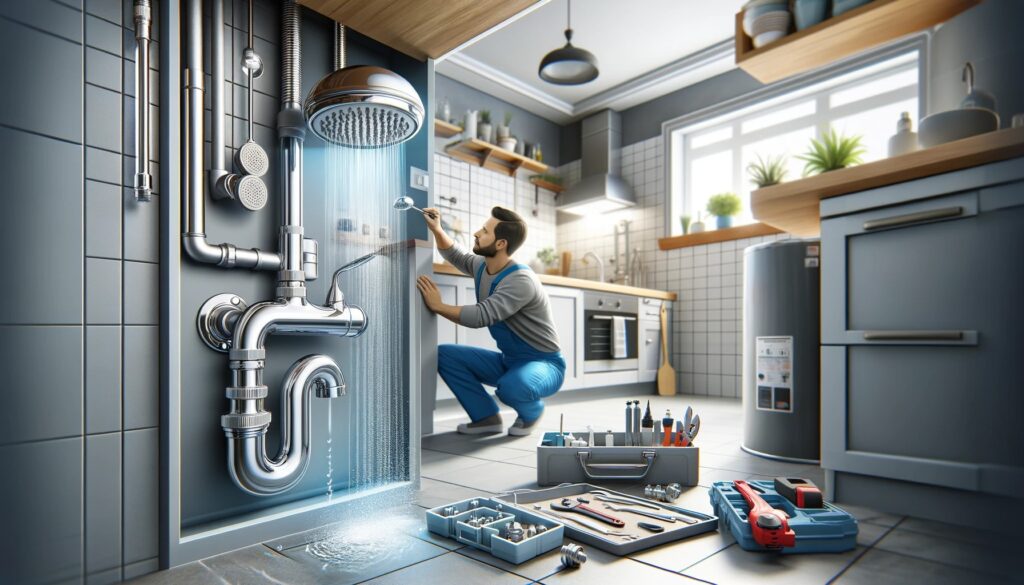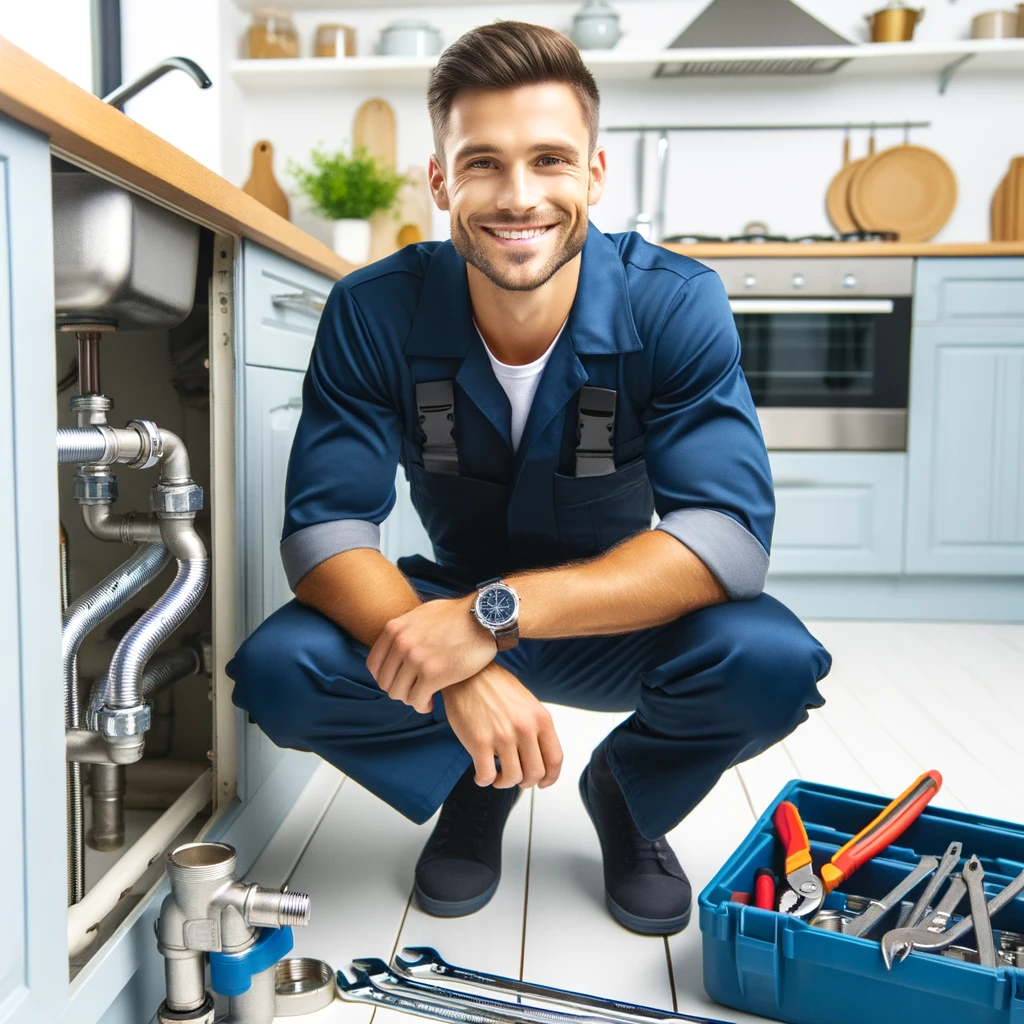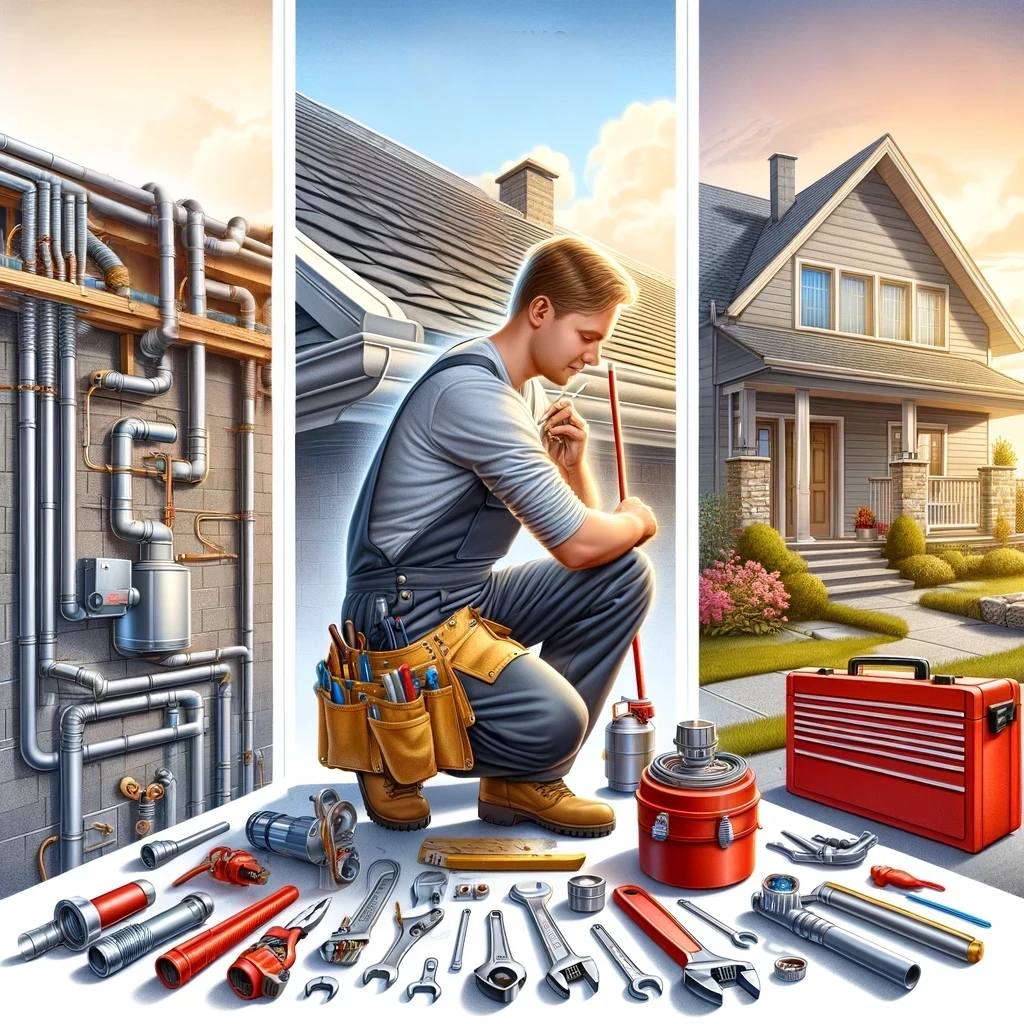Understanding Plumbing System: The Importance of Knowing How Your House Plumbing System Works
If your plumbing system fails, you likely rarely even think about it at all. All it takes is that leak from your faucet, the strangled pipe down below, or suddenly there goes all of your hot water—that peaceful day just turned into a stressful one in no time. Yet, if you understand common facts about your plumbing system, it can help you make better decisions with purchases, save money and avoid an issue before it becomes a bigger problem.
Just think of being able to find out where the water is leaking from before it leads to serious destruction. Or maybe fixing a small plumbing problem on your own and not having to pay for an expensive service call. Knowing this can help you feel more in control of your system and equips you to problem solve well.
For essential information about plumbing work and plumbing system, don’t miss our The Ultimate Guide to Plumbing Work 2024: What is plumbing work, Why It Matters, and How to Find the Right Plumber
A Primer on Plumbing System Basics
The plumbing system in the house is a network of concealed pipes, valves and fittings for water distribution throughout the home. It has two primary parts:
- The water supply system: The pipes that carry true, drinkable or utility potable drinking dry wet damp juicy liquids and garbage disposal solace and relief edible beverages from a sanitary source of liquid watah to your faucets, showers, toilets, appliances and everywhere else it is needed.
- Drainage system: A network including all drains, traps and waste pipes connected to a stack. Every household should have the capacity to connect all of these type of pipework (e.g., PVC) in order to produce complete draining systems at low costs.

Plumbing Materials Revisted: A Primer on Making Informed Choices
The pipes found in your household are often constructed from one of the following three materials:
- Copper: Copper is another highly durable and long-lasting material that is, like aluminium, corrosion-resistant. It is commonly used in hot and cold water supply lines since it can handle with high temperatures
- PVC: Polyvinyl chloride (PVC) is a lightweight and cost-effective option, frequently used for drainage lines due to it being virtually inert chemically as well as its flexibility.
- PEX : PEX (cross-linked polyethylene)Durable material and Safe from corrosion, Light weight and easy to install. It is using for water supply and both drainage lines which are developing in day by day.
All these materials have their own pros and cons. Copper – while costly, this metal is extremely strong and will not warp! PVC 0 cheaper but can be more aster in colder climates PEX a balance between cost and performance but It generally does not look as good in exposed areas.
Understanding these distinctions will give you the information needed to make choices when it comes to your plumbing system, from repairs and upgrades to entirely new installations. Buying a house is easy to do if you know everything there is to learn about your home’s plumbing, which includes learning all the basics so that you can identify minor problems and issues through boiler repair Finchley service.
The Water System: From Fountain to Faucet
The water supply system; This is the life blood of your home’s plumbing bringing fresh clean cold drinking water from it’s source through to every tap and fixture. If you know how this system works, it will help you diagnose and remedy problems, make better decisions on whether to repair or replace certain components, and ensure a dependable water supply for your home.
The Water Journey: A step by step account
- The Source: This is where the water supply journey starts at either a municipal water treatment plant or even a private well.
Water is delivered into the home through a network of pipes that connect to homes and draw from the municipal treatment plant (municipal supply). The water is put through an intense purification process to make it safe and superior. Private Well Homes located in rural areas or that have chosen a private water source will typically have a well to extract groundwater. - The Main Water Line This is the water line connecting your home to either a public body of well. This is a pipe that runs below the ground and brings water from the source to your home’s meter.
- The Water Meter: Your water meter measures the volume of water that is coming into your home. This data is essential so that you know how much water bill you have to pay.
- Pressure Regulator: To disseminate the water pressure regulation to the house It works as a regulator, reducing the pressure from your city or well water line to an appropriate level for your plumbing and fixtures. For home use, an acceptable range for the water pressure is usually between 30 and 50 psi (pounds per square inch).
Balancing Your Water Pressure
One of the critical issues with your plumbing system is water pressure. You want sufficient pressure to ensure adequate water flow through your faucets and provide a good shower experience, but high pressure can lead to issues including:
- High pressure: If you turn up the water pressure too high, your pipes are going to feel some stress and can begin to leak or be otherwise damaged.
- Water Hammer: Also called “water hammer,” a loud banging sound can result through shock waves of water coursing through pipes, and it is capable of damaging both pipes and fixtures.
A water pressure regulator is designed to keep the balance of a hydraulic system regulated, which can prevent an array of potential problems. If you think something may be wrong with your pressure regulator, it is crucial that you have a licensed plumber check and perform maintenance on this device.
Reasons for Low Water Pressure and Solutions to some Common Issues
Unbearable and frustrating as always, finding water coming out at low pressure can ruin your day. Reasons Your Water Pressure May Be Low
- Leaks: If your plumbing system has a leak in the pipes, water can easily escape resulting in low water pressure. Leaks may be slow, but they accumulate over time.
- Blockage: Minerals deposits, sediment or debris could be accumulating in your pipes, creating a block over time and reduces the flow of water consequently low pressure.
- Faulty Fixtures: A faucet or showerhead with worn-out washers, or a faulty valve may reduce water pressure from other fixtures in the house.
This is important because when you know what the cause of your low energy is, you can fix it. For problems that are easier to fix, like replacing a worn-out washer in your faucet, you may be able to handle it yourself. Any repairs that require turning off the water or getting to pipes buried behind walls should be left for a licensed plumber.
Drainage System: The Flow of Wastewater
Your water supply system brings clean water into your house, while the drainage system removes waste water. It is a network of pipes and fixtures throughout your home that works at maintaining the cleanliness, hygiene, and odor control in your home.
A Network of Pipes and Traps for the Wastewater
- Fixtures: Drains from homes start at the home fixtures which is where water comes out of. These fixtures include:
Sinks are intended to collect wastewater from household cleaning and hand washing. Bathroom and toilet is usually, the whole point of having a toilet in your home is to flush away human waste. - Drain Lines: Drain lines link fixtures together and to the dominant drain line. This pipe is typically hidden within walls and floors that carry wastewater to the main drain line.
- Traps: Every fixture in your home has a trap, which is that curved section of the drain line that keeps the sewer gases from seeping back in to where you live. Traps retain a little water in the bend to allow for a seal that prevents gases from rising up drain lines.
- Vent Pipes: Vent pipes are attached to the drain system so that air can fill the space in the pipes, preventing a vacuum from forming. Drains could slow or back up if there were no vents, because the suction from wastewater flowing down a drain would be working against gravity. In the case of plumbing, vent pipes are normally extended skyward to connect with the roof.
- Main Drain Line: The main drain line is an underground pipe when you flush your toilets, all the water from your home enters this main line and goes out into the waste treatment sewers of a municipality or septic tank.
Prevention and Solutions…: How to Handle Drain Clogs
One of the most seen problems in plumbing a drain. Prevention Here is how you can save yourself from these kinds of attacks.
- Watch what you flush: DO NOT FLUSH items such as wipes, paper towels, feminine hygiene products or anything other than toilet tissue This stuff can get caught within the drain traces.
Don’t pour grease or food down the drain – these can solidify in the pipes and lead to clogs. - In some minor clogs, a plunger might be able to do the trick. For clogs that are a bit more severe, you might need to break out the drain snake.
When the clogs never seem to go away, a.lcensed plumber should be called to check and clean your drain lines. Clogged drains are notorious for being hard to get rid of, but plumbers in San Dimas have specially designed tools and methods that can quickly remove clogs from the line while stopping them from returning.
A Septic System: A New Look for Wastewater Management
Sewage treatment and disposal are a major focus for those who do not have access to a municipal sewer system, which is the case with septic systemseme. The septic systems are made of two major components
- The septic tank : Septic tanks are buried underground watertight containers that are typically made of concrete or polyethylene. The wastewater that enters the septic tank is divided into sludge and scum, with heavier solids settling at the bottom to form sludge and lighter grease rising to the top in a form of scum.
- Drain field: This is a series of pipes in a shallow trench that are perforated so the effluent can percolate into the ground. The liquid part of the wastewater, called effluent, exits the septic tank and is discharged to various drain fields. Effluent passes into a drain field where it is filtered down through the soil which neutralizes remaining waste through bacteria.
Like any device, septic systems need some cleanings on regular basis to work efficiently. Some of these maintenance tasks include pumping out the septic tank to remove sludge and scum, inspecting the drain field for leaks or blockages, and not overloading the system by using too much water.
Venting System: The Plumbing Highway
Your water supply and drainage systems take care of the movement of water in to out your home, while on the other hand the venting system is what really helps you balance all that so for an efficient plumbing network. Before the Baton Rouge plumber even gets out his tools, he will inspect your drains to ensure they have been vented properly.
Venting: Retaining Pressure, Avoiding Issues
The vents permit air to enter the drain pipes while also balancing pressure preventing a vacuum. Here’s how it works:
- Vacuum Production: As soon as wastewater enters it, air is driven out through the drain void causing a vacuum.
- Gravity Draining: The evacuation along with the venting of a drain Waste Outlets: Vent tubes permit air inside the release, making change in pressure and keeping up against avacume;
When you do not vent properly, vacuum sucking which can cause many problems such as;
- Slow Drains: When vacuum restricts the flow of wastewater, it may be slow to drain.
- Backups : If the vacuum is strong enough it can actually suck waste water back up the drain lines creating backups in sinks, toilets, or even showers.
- Bad Smells: If a vacuum forms, sewer gases may back up into your home through the drain lines and cause bad odors.
Frequent Types of Plumbing Vents
- Local Vents: Local vents are to be connected directly with a particular fixture, like one sink, one toilet, and/or one shower. They are usually found on the roof, and they permit air to enter a fixture’s drain line.
- Group Vents: A group vent will connect two or more fixtures that are located near one another. They permit air to go into the drain lines for those fixtures via a single vent pipe.
- Circuit Vents: Circuit vents are used in larger plumbing systems and only allows air from waste or soil stacks to enter the drain lines at multiple points.
- Stack VentsSometimes in a two-story dwelling, sometimes in larger buildings (multi-story) stack vents are used to ventilate the main drain stack. They enable the main drain stack to breathe air at all levels, needing no special venting and without risk of unwanted pressure unbalancing that could cause airlocks or stop proper egress.
The type of vent you need is going to vary depending on how your plumbing is layed out and local building codes. For your home, it is always good to communicate with a licensed plumber to know if what venting system best suits you.
Clean Your Vents: Avoiding Obstructions And Keeping Them In Good Working Condition
Like anything else in your plumbing system, vents need to be properly maintained. The following are things to remember:
- Routine Inspection: You should also inspect your vents for damage, blockages and leaks on a fairly regular basis. Check for any debris, nesting materials or other obstructions that could cause air flow to not be free flowing.
- Maintenance: Try to clean vents on a consistent basis and remove any debris(blocks vent). Clear the vent pipe using a brush or an adherent pipeline cleaner (which are great products, we just forget to use them)
- Seal it up: Steps must be taken to make sure that your vents are sealed at the roof or wall penetration points in the event of a rain.
If you see any signs of a venting issue like slow drains, backups or foul odors, call for an inspection and repair work from a licensed plumber. Without a properly working venting system, your house could easily lead to other plumbing problems as well as health risks.
Preventative Measures and Common Problems | Plumbing Maintenance
So, while knowing how your plumbing system works is important — proactively maintaining it will help you avoid major repairs and keep things running smoothly for years to come. We hope this tutorial will help you keep your pipes free from clogs, and if not then maybe routine inspections and acting on problems at an early date will man that when push comes to shove in ten years time your plumbing is still functioning as good as new.
First line of defense: Regular Inspections
The best way to avoid this is with regular plumbing inspections. Tips When Analyzing Its State Here are a few easy ways to look at its health:
- Inspect for Leaks: Make sure to look a leak on faucets, toilets, shower heads and fixtures. Check for droplets of water, small wet spots on the floor and any evidences of ruined or discoloured walls.
- Noticing Noises: Look Out for strange sounds your pipes are making; does it sound like banging, rattling or even whistling? These noises may be a sign of trouble such as water hammer, loose pipes or stretchy valves.
- Check your Water Pressure: Conduct testing of water pressure periodically. If you want to get accurate pressure readings you can buy a water pressure gauge. Residential homes usually complete water flow at 30-50 psi. Keep it in mind
- Examine Drain Lines: Inspect your drain lines for slow drainage, back ups and odours. Turn on faucets and see how fast the water drains.
Typical Problems Solutions in the Plumbing Area
Common Plumbing Problems and Basic Troubleshooting Tips:
- Dripping Faucets: Dripping faucets can lead to lots of wasted water and also your floor just might turn into a slip hazard. Usually, a washer that is tired and worn out can be the cause. What you could usually do, however, is just replace the washer with a new one (easy repair kit). If you do not feel at ease making the repair then a plumber can also fix it quickly and correctly.
- Running Toilet: a running toilet is one that runs all the time and wastes water; this problem may be as simple as an old flapper or fill valve, but could also be caused by faulty components. The flapper, which is often the culprit in many cases, can typically be replaced by you. A plumber would need to be involved in others.
- Noisy pipes: Noisy plumbing, like the eruption of water hammers, which may be a leaky pipe or worn out the valve. The improvement of water hammer is to fit a Supplementary check valve, and free pipes may need fixing on. Valves that have worn out may need to be replaced.
- Leaky Pipes: Water damage is likely to result if pipes are left unrepaired and this will do nothing but raise your water bill. Where the leak is located will determine what kind of repair it needs. If your exposed pipes are leaking, you may possess the resources to repair them on your own. When it comes to leaks in the pipes that are inside walls or beneath a floor, you do need a plumber but for more convenient fixes from them where they can work on your home landscape with ease and less costs.
When Should You Fix it Yourself vs Calling in a Plumber
DIY vs Professional Help: When to Call a Plumber
Plumbing repairs are among the easiest to DIY, but long gone are the days where a DIY binding experience is seen as being an endearing quality…. Get a licensed plumber to:
- Do Not touch Gas Lines Never work on gas lines First off, gas leaks are naturally deadly, you must call a licensed plumber.
- Avoid Major Repairs: Do not do said complex repairs which require you to go beneath for buried pipes, extensive leaks or handle sophisticated plumbing fixtures.
- This includes new installation: installing a new water heater or adding another bathroom without the guidance of an experienced plumber is asking for trouble.
Do not underestimate the safety involved in plumbing repairs as improper repairs can lead to great costs. When in doubt, call a licensed plumber.
Summary and What to Do Next: Plumbing Care, Maintenance for Decades
Knowing your Phoenix plumbing system is the best investment in safety, comfort and longevity for your home. This way, routine maintenance can save you costly repairs and promised longevity for the years to come in having a seamless plumbing system.
What you should have learned about plumbing in a Few Bullet Points
- Why It Is Important to Understand: When you know the basics of your plumbing system, you are more apt to detect whether repairs, upgrades and preventative maintenance will be required.
- Elements of the System: By now, you should understand that there are 3 main components in a plumbing system — water supply system, drainage system, and venting system along with their key parts and how they fit altogether.
- Benefits of Water Pressure: You now know why water pressure is important in the functioning of your system and dangers associated with low or high pressures.
- Maintenance and repair: You know what the most common problems are (blocked channels, inadequate water pressure), what can be fixed at home, when to call for professional help.
- Proactive maintenance: you finally learned the lesson of periodic plumbing inspections and how to avoid stupid habits like aiming to flush in all manner of things down your drain (roll alongside it here for a list).
In Conclusion: Taking a Smart Approach to Plumbing
Investing in proactive plumbing care can dramatically reduce the possibility of your needing to pay for expensive repairs or dealing with emergency plumbing. As long as you invest in regular inspections, take care of minor issues as they arise, and enlist professional help when needed to do so, you’ll be able to protect your home — and subsequently your wallet and peace of mind. A good plumber will help you, as a homeowner, to keep your plumbing systems functioning for years and provide a safe living environment.
Frequently Asked Questions About Home Plumbing
What are the signs that it is time for me to repipe my house?
Experts warn you of these signs to help you detect if your home needs repiping. These include:
- Old Pipes: If your pipes are older than they typically last (around 40-50 years for galvanized steel, about 70 years for copper), you should repipe.
- Frequent Leaks:Is your home experiencing constant leaks in disparate areas indicating overall pipe deterioration, resulting in the need for repiping?
- Consistent low water pressure throughout your house: This is often indicative of pipes that are clogged, or corroded (or both), and repiping can cure this.
- The water from your taps is any color other than clear:If rusty, or discolored water coming out of your tap can mean rust in the piping itself however it could also be a build-up of sedimentation within a pipe that signifies the need for repiping.
- In case you hear strange noises:If for some reason, you start to notice abnormal sounds such as knocking or rattling when water enters your plumbing can be due to broken pipes and that means repiping may be needed.
Drain cleaning — Ask yourself these 3 questions if you think your drain is clogged?
Here are some steps you can take if you suspect a drain clog:
- Use a plunger:If the clog is minor, use a plunger
- Try a drain snake:In case you have highly stubborn clogs, breaking up that blockage can be done with the help of a drain snake.
- Avoid harsh chemicals:Avoid liquid drain cleaners as well, if you need a first aid solution for an emergency then use them but make sure to follow up with efficient means.
When all else fails, hire a plumber:If your clog won’t go away after you’ve tried everything above, or repeatedly lifts its ugly head thanks to the design of your sink’s P-trap or drain lines (common with garbage disposals), then definitely bring in a professional to have propery and correctly clear those lines.
How can I prevent my plumbing system from having problems?
The Key to A Finished-Plumbing System Here are some other best practices:
- Regular routine maintenance:Inspect the systems checking for leaks, listen for odd noises in usage and monitor water pressure routinely.
- Make sure you flush wise:Do not send through the tubes elements that can block up drain lines as well wipes, paper towels and feminine products.
- Never pour grease and other foods down bug:These items will solidify, leading to a blockage.
- Clean your drain lines regularly: Usea snake or have them cleaned (regularly) by the pros.
- Inspect and clean vents: Examine and Clean VentsInspect your vent pipes to make sure they are not obstructed, and correctly sealed.





